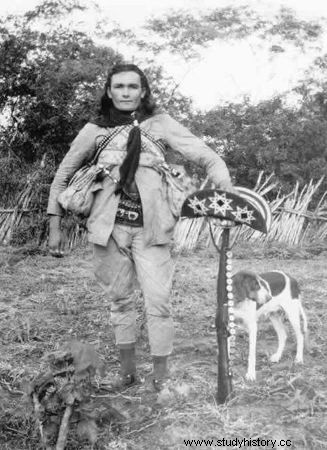
By Me. Cláudio Fernandes
The cangaço was a movement characterized as social banditry that prevailed between the last decades of the 19th century and the first half of the 20th century in the areas of the Brazilian northeastern sertão. The figure of the cangaceiro is characterized by the sertanejo always on the move, with a semi-nomadic life, living in packs and wearing tanned leather clothes, armed with rifles, knives (fish holders) and daggers. This type of countryman carried the stuff he needed, all strapped to his trunk. That's why the name “cangaço”, attributed to this way of carrying belongings and groceries.
Among the first historical records of cangaço activity are the actions of Jesuíno Alves de Melo Calado , known as “Brilliant”. Brilhante acted as a bandit of the cangaço in the 1870s, and many romanticized and folkloric legends were born around him. But it was the bandits active in the 20th century who had the greatest fame, inspired the greatest terror and had the greatest impact on Northeastern society.
It is worth mentioning that the practice of cangaço is also associated with economic and social issues that have always plagued the Northeast of Brazil. The wave of droughts prolonged periods through which the Northeast went, such as those of 1877 and 1915, decimated a very large number of people, in addition to causing the migration of many others and the evolution of misery among those who remained there. This climate of social and economic chaos led to the emergence, during the Republic, of clientelist forms of politics. and colonelista, that is, the establishment of relationships of direct dependence between the humble and miserable population with the large landowners of these regions.
Between the 1920s and 1930s, several reactions to the coronelista system were seen in the Northeast. The cangaço was one of them. Names like Virgulino Ferreira da Silva , the Lantern , Cristino Gomes da Silva Cleto , the Corisco, and José Ribeiro Filho , Zé Sereno , were the main cangaceiros of that time. Each of them had their own band, which operated in specific regions of the sertão. The main confrontations of the cangaceiros were against the official troops of the states and against the troops of jagunços (mercenaries hired by farmers).
After the death of Lampião, in 1938, in Sergipe, by state troops, bandits like Corisco and Zé Sereno decided to surrender to the forces of the Vargas New State, in favor of acquittal of crimes and amnesty.
Take the opportunity to check out our video lesson related to the subject:
